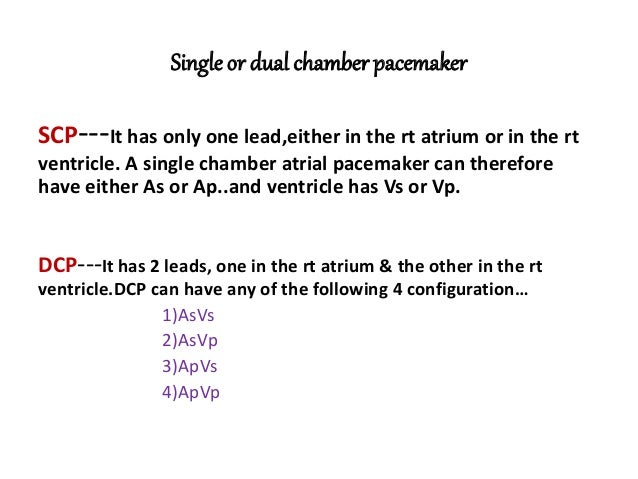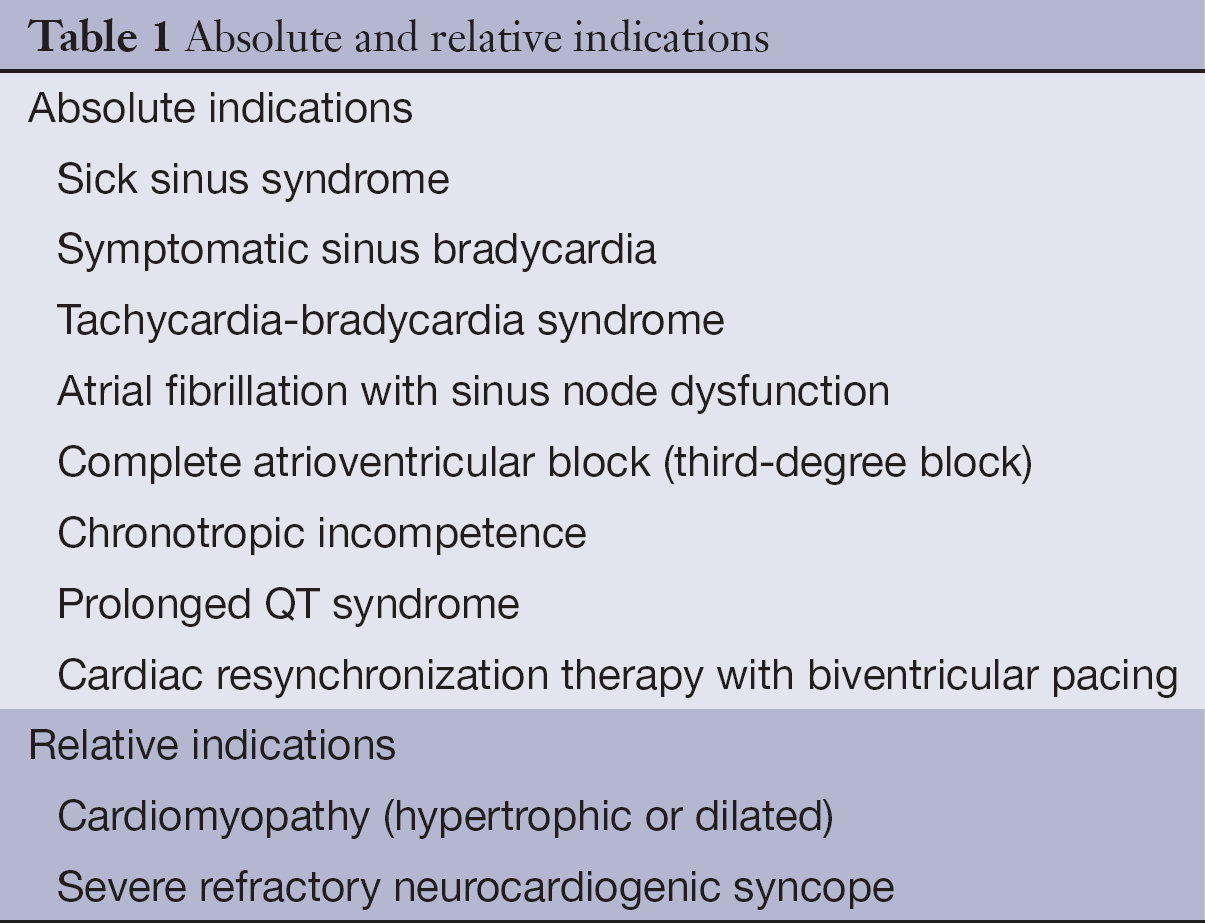
Key clinical indications. Single-chamber pacemaker. One lead in RV. VVI. Symptomatic bradycardia (high degree AV block, sinus node dysfunction) Prolonged asymptomatic pauses or high degree AV block. Tachycardia-bradycardia syndrome. Reflex asystolic syncope. Cardiac syncope in presence of bundle branch block with other features suggestive of conduction failure. Dual-chamber pacemaker Single-lead (or single-chamber) pacemakers (see Fig. ), as their name indicates, are used to stimulate only the right atrium or right ventricle. Atrial single-lead pacemakers (with the lead positioned in the right atrium) can be used to treat isolated sinus node dysfunction with normal AV conduction (Fig. ). In the United States, single-lead atrial pacemakers are rarely implanted. Even patients with · Similarly, when pacemaker implantation is indicated, the guidelines state that consideration should be given to implantation of a more capable device if it is thought likely that the patient will qualify for the latter within a short time period. More “capable” devices include CRT, pacing but not defibrillation capability (CRT-P), or CRT with defibrillation capability (CRT-D)
Pacemakers and cardiac devices in
ACCEL In recent years, major studies have been reported, advancing our knowledge of the natural history of bradyarrhythmias and tachyarrhythmias, which may be treated optimally with device therapy.
There have also been major advances in the technology of devices that can delay and even prevent morbidity and mortality from arrhythmias and heart failure HF. Pacing was once a fairly straightforward technology.
Today, single chamber pacemaker indications, once the decision has been made to implant a pacemaker in a given patient, the clinician must decide among a large number of available pacemaker generators and leads.
The TABLE summarizes the appropriateness of different pacemakers for the most commonly encountered indications for pacing.
An important challenge for the physician in selecting a pacemaker system for a given patient is to anticipate the progression of abnormalities associated with the need for a pacemaker in the first place in order to a select a system for the present that will best accommodate these developments later.
Thus, current guidelines state that it is reasonable to select a pacemaker with more extensive capabilities than needed at the time of implantation but that may prove useful in the future. Similarly, when pacemaker implantation is indicated, the guidelines state that consideration should be given to implantation of a more capable device if it is thought likely that the patient will qualify for the latter within a short time period.
For example, the guidelines cite a patient who requires a pacemaker for heart block that occurs in the setting of MI who also has an extremely low LVEF, single chamber pacemaker indications, who may be best served by initial implantation of an ICD rather than a pacemaker. In such cases, guidelines state that the advantage of avoiding a second upgrade procedure should be balanced against the uncertainty regarding the ultimate need for the more capable device.
There is a role for CRT-P in some patients, single chamber pacemaker indications, especially those who wish to enhance their QOL without defibrillation backup. The guidelines note that elderly patients with important comorbidities are such individuals. Notably, there is an important survival benefit from CRT-P alone. There is a significant underutilization of implantable cardioverter-defibrillators and CRT among women compared to men.
However, women do not seem to benefit from primary prevention ICD therapy to single chamber pacemaker indications same single chamber pacemaker indications as men. Kristen K. Patton, MD, and colleagues have reported that women with HF have a lower mortality than men, and fewer of those deaths are sudden throughout a spectrum of all-cause mortality risk. One meta-analysis revealed no statistically significant decrease in all-cause mortality in women with heart failure who received ICDs hazard ratio: single chamber pacemaker indications. Importantly, the differences are not explained by differences in baseline characteristics.
Indeed, in terms of magnitude of benefit from CRT, single chamber pacemaker indications, the greatest benefit is seen for females, wider QRS, LBBB, and nonischemic cardiomyopathy.
Intermediate benefit is seen among males and individuals with ischemic cardiomyopathy, while the lowest benefit nonresponders have narrower QRS or non-left bundle branch block. Indications for Pacing: Making Sense of the Guidelines Single lead, Biventricular, or Single chamber pacemaker indications Jan 15, CardioSource WorldNews Share via:.
Limitation of the Class I indication to patients with left bundle-branch block LBBB pattern, single chamber pacemaker indications. Men and Women There is a significant underutilization of implantable cardioverter-defibrillators and CRT among women compared to men.
References Tracy CM, Epstein AE, Darbar D, et al. J Am Coll Cardiol. Ghanbari H, Dalloul G, Hasan R, et al. Arch Intern Med. Cheng A, Gold MR, Waggoner AD, et al, single chamber pacemaker indications. Heart Rhythm. Share via:. Guidelines JACC Journals on ACC. org JACC JACC: Basic to Translational Science JACC: CardioOncology JACC: Cardiovascular Imaging JACC: Cardiovascular Interventions JACC: Case Reports JACC: Clinical Electrophysiology JACC: Heart Failure Membership Current Members Campaign for the Future Become a Member Renew Your Membership Member Benefits and Resources Member Sections Chapters ACC Member Directory About ACC ACC Innovation Program Our Strategic Direction Diversity and Inclusion Our History Our Bylaws and Code of Ethics Leadership and Governance Industry Relations Support the ACC Jobs at the ACC Press Releases Social Media Book Our Conference Center.
Clinical Topics Acute Coronary Syndromes Anticoagulation Management Arrhythmias and Clinical EP Cardiac Surgery Cardio-Oncology Chronic Angina Congenital Heart Disease and Pediatric Cardiology COVID Hub Diabetes and Cardiometabolic Disease Dyslipidemia Geriatric Cardiology Heart Failure and Cardiomyopathies Hypertriglyceridemia Invasive Cardiovascular Angiography and Intervention Noninvasive Imaging Pericardial Disease Prevention Pulmonary Hypertension and Venous Thromboembolism Sports and Exercise Cardiology Stable Ischemic Heart Disease Valvular Heart Disease Vascular Medicine.
JACC Quality Improvement for Institutions NCDR CardioSmart MedAxiom Accreditation Services Contact Us Heart House N Street NW Washington, DC Phone:single chamber pacemaker indications, ext. org Fax: Media Center ACC. All rights reserved.
Installing a pacemaker: indications and contraindications | Competently about health on iLive

Therefore, the following indications are covered for implanted permanent single chamber or dual chamber cardiac pacemakers: Documented non-reversible symptomatic bradycardia due to sinus node dysfunction. Documented non-reversible symptomatic bradycardia due to second degree and/or third degree atrioventricular block AAI single-chamber pacemakers or the programming of the AAI mode in a dual-chamber pacemaker are formally contraindicated in patients with permanent or paroxysmal atrioventricular conduction disorders. They should also be avoided in patients with vagal symptoms or carotid sinus syndrome Single chamber atrial pacemakers are uncommonly placed, as they require intact atrioventricular conduction and do not safeguard against its future deterioration. Indications include severely symptomatic sinus bradycardia and the sick sinus syndrome (with the tachycardia-bradycardia syndrome). Lead placement is typically in the right atrial appendage
Keine Kommentare:
Kommentar veröffentlichen